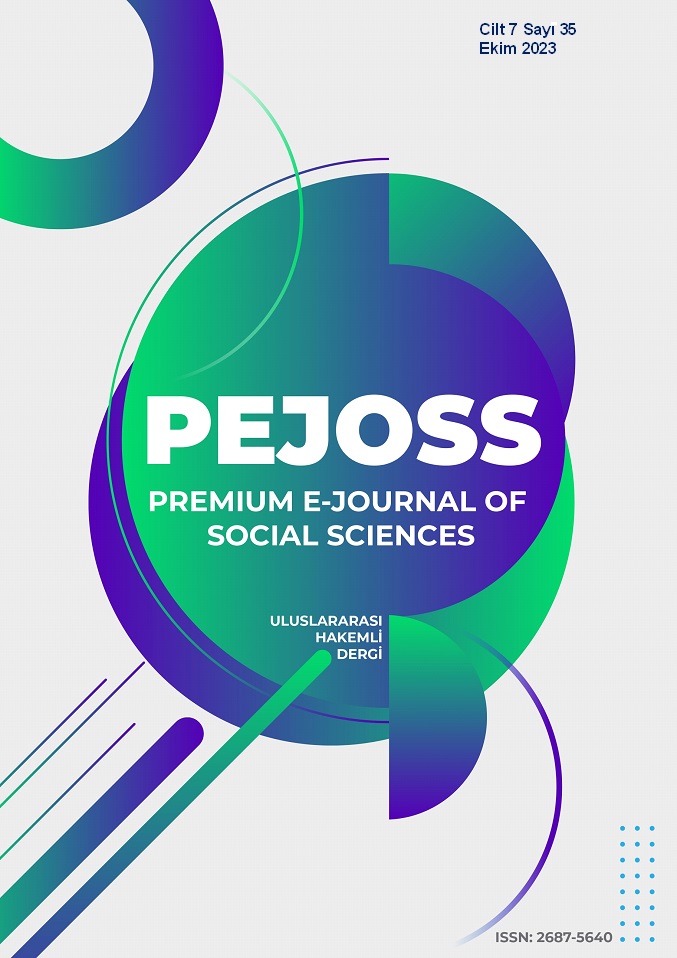Projections of Arabesque Codes in Rap Music: “We Are Bad, Exactly”
DOI:
https://doi.org/10.5281/zenodo.10035564Keywords:
Music, arabesque, hiphop, rap, discourse analysisAbstract
Music is one of the oldest and universal languages of humanity. Musical works are produced and consumed for various purposes in many sectors, from therapy to religious rituals. However, music is an important part of today’s entertainment industry. Music is a part of our lives almost everywhere, on the streets, in cafes, restaurants, and in vehicles. Music is also the most important means of transferring culture. Thanks to music, not only cultural elements but also religious, political, or commercial messages can be produced and spread. In particular, current music, which is one of the most important carrier channels of popular culture, is produced in a way that can be consumed with pleasure and speed. Although musical genres differ in the instruments used, the style of vocalization, the target audience, and structural elements, they may have similarities at some points. In this context, there are similarities and differences between arabesque and hip-hop music in various aspects. Both arabesque and rap music, in terms of their philosophy of emergence, are the types of music in which those who are left outside the center, excluded and marginalized due to economic or social inadequacies seek solace or express their rebellion.
From this perspective, it is possible to encounter intertwined forms of discourse in arabesque and rap music songs. This study aims to verify the hypothesis mentioned above that rap music carries arabesque codes. Within the scope of the study, the song “Aynen” (Exactly), performed together by rap singers Heijan and Muti, was determined as a sample and the verbal elements of the song were analyzed using the discourse analysis method. According to the findings, it was concluded that there are discourses regarding arabesque music in rap music.
Downloads
References
A-Haber (2023). https://www.ahaber.com.tr/galeri/yasam/heijan-muti-big-ve-cac-gozaltina-alindi-istanbulda-rapcilere-sok-operasyon/13.
Arıcan, T. (2021). Türkçe Rap’in Dönüşüm Evrelerinde Geçişkenlikler: Direniş, Marjinalleşme ve Tarz. Eurasian Journal of Music and Dance (18), 53-69. doi:10.31722/ejmd.956687
BBC (2019). https://www.bbc.com/turkce/haberler-turkiye-49610797.
Blanchard, B. (1999). The Social Significance of Rap & Hip-Hop Culture. Ethics of Development in a Global Environment (EDGE). Poverty & Prejudice, Media and Race, July, (26). ttps://hiphoparchive.org/sites/default/files/the_social_significance_ of_rap_hip_hop_culture.pdf
Bozkurt, S. S., Zahal, O., & Uyan, Z. D. (2015). Ortaokul Öğrencilerinin Duygu Durumlarına Göre Dinledikleri Müzik Türlerinin İncelenmesi. The Journal of Academic Social Science Studies (39), 541-567.
Ceza (2021). Ceza: İstanbul’un her semtinden rap yükseliyor. (T. Akyılıdız, Röportaj Yapan) istdergi. (27 Kasım 2021). https://www.istdergi.com/roportaj/ceza-istanbulun-her-semtinden-rap-yukseliyor adresinden alındı
Çelik, H., & Ekşi, H. (2008). Söylem analizi. Marmara Üniversitesi Atatürk Eğitim Fakültesi Eğitim Bilimleri Dergisi, 27 (27), 99-117.
Der.gy (2022). https://www.dergy.com/en-iyi-12-rap-sarki-sozu/
Dilben, F. (2016). Varoşların Sözü: Arabesk-Rap Bağlamla Rap Müzik. [Yayımlanmamış Yüksek Lisans Tezi]. Sosyal Bilimler Enstitüsü. Hacettepe Üniversitesi.
Duran, S. (2012). Türkiye’de Âşıklık Geleneğinin Popüler Müziklere Etkisi. DOĞU BATI Düşünce Dergisi (62), 225-250.
Güngör, N. (1993). Arabesk Sosyokültürel Açıdan Arabesk Müzik. Bilgi Yayınevi.
Gürbilek, N. (2001). Vitrinde yaşamak. Metis Yayınları.
Gürsoy, E. C. (2012). Bir Altkültür Tezahürü Olarak “Arabesk Rap”. Birikim, (285), 93-97.
Halnon, K. B. (2009). Hip-hop. George Ritzer (Ed.), The Blackwell Encyclopedia of Sociology içinde (s. 3486-3487). Blackwell Publishing.
Hürriyet (2023). (https://www.hurriyet.com.tr/avrupa/apache-207-rollerle-tum-zamanlarin-rekorunu-kirdi- 42233931#:~:text=Apache%20207%2C%202019'da%20%C3%A7%C4%B1kan,Christmas'%C4%B1%20da%20geride%20b%C4%B1rakt%C4%B1.
Işık, N. E. (2017). Müzik Sosyolojisi Açısından Arabesk Müziğin Dönüşümü. Sosyoloji Dergisi, 38(1), 89-106.
İHA (2023). https://www.iha.com.tr/haber-cumhurbaskani-erdoganin-mitinginde-konser-veren-sanatcilara-tehdit-yagdi-1168030.
Kaya, A. (2002). Aesthetichs of Diaspora: Contemporary Minstrels in Turkish Berlin. Journal of Ethnic and Migration Studies (28), 43-62.
Kırık, A. M. (2014). Türk Sinemasında Arabesk’in Doğuşu ve Gelişimi. Gümüşhane Üniversitesi İletişim Fakültesi Elektronik Dergisi, 2(3), 90-117. doi:10.19145/guifd.72556
Lüküslü, D. (2011). Ulusaşırı Bir Gençlik Kültürü ve Toplumdan Saygı Talebi Olarak Hip-Hop. Toplum ve Bilim (21), 201-222.
Marketing Türkiye (2019). https://www.marketingturkiye.com.tr/haberler/spotify-2019un-en-cok-dinlenenlerini-acikladi/
McCoy, A. (2017). Rap Music. In Oxford Research Encyclopedia of American History. (https://doi.org/10.1093/acrefore/9780199329175.013.287).
Mirac (2019). Rap müzik sanatçısı Mirac: Susamam’dan çekilince ölüm tehditleri aldım. (S. Dursun, Röportaj Yapan) Yeni Şafak. https://www.yenisafak.com/hayat/rap-muzik-sanatcisi-mirac-susamamdan-cekilince-olum-tehditleri-aldim-3517549
Özbek, M. (1991). Popüler Kültür ve Orhan Gencebay Arabeski. İletişim Yayınları.
Rapertuar (2021). https://www.rapertuar.com/haber/spotify-yilin-en-cok-dinlenenlerini-acikladi-ezhel-drake-bad-bunny-sefo-ve-digerleri/
Rapertuar (2022). https://www.rapertuar.com/nedir/sample-nedir/
Richardson, J. W., & Scott, K. A. (2002). Rap Music and Its Violent Progeny: America's Culture of Violence in Context. Journal of Negro Education, 71(3), 175-192. doi:10.2307/3211235
Taşal, B., & Vural, F. (2011). Şarkı Sözlerinde Şiddet Öğesi: Aksaray İli İlköğretim İkinci Kademe Öğrencileriyle Yapılan Bir Çalışma. Selçuk Üniversitesi Sosyal Bilimler Enstitüsü Dergisi (25), 252-259.
Taydaş, O., & Sert, H. (2021). Bir Popüler Kültür Ögesi Olarak Arabesk Müziğin Çevreden Merkeze Yolculuğu. Selçuk Üniversitesi Sosyal Bilimler Enstitüsü Dergisi, 45, 210-222. doi:10.52642/susbed.899282
Teknoblog (2022). https://www.teknoblog.com/spotify-2022-yilin-ozeti-yayinladi/
Ünür, E., & Bilgili, A. (2021). Kuşakların Karakteristik Özelliklerini ile Müzik Tercihleri Arasındaki İlişki: Bebek Patlaması ve Z Kuşakları Üzerine Python Analizi. USBAD Uluslararası Sosyal Bilimler Akademi Dergisi, 3(6), 1473-1499.
Downloads
Published
How to Cite
Issue
Section
License
Copyright (c) 2023 Premium e-Journal of Social Science (PEJOSS)

This work is licensed under a Creative Commons Attribution 4.0 International License.


